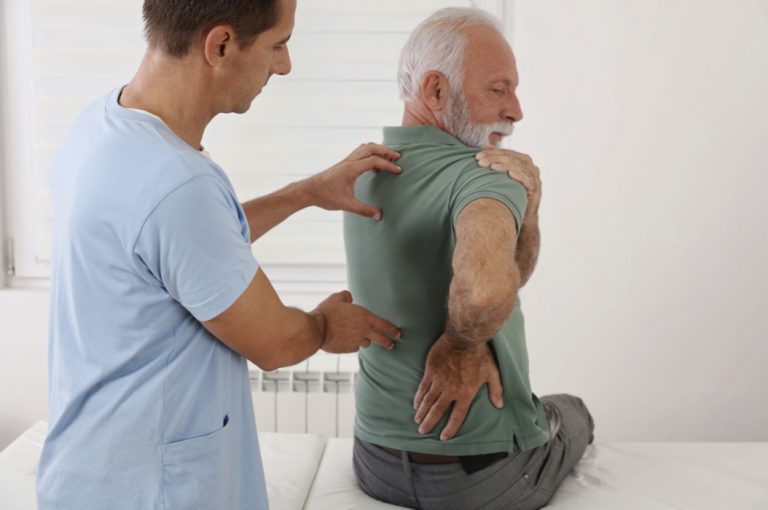Spinal stenosis, the medical term for narrowing in the spinal column, is a very common condition. It affects hundreds of thousands of people in the United States alone. Symptoms of spinal stenosis range from mild to severe, depending on the location and degree of compression of the spinal nerves. If you’ve been diagnosed with spinal stenosis, or even if you’re just researching potential sources of neck or back pain, learning more can be helpful.
By gaining a clear understanding of the spinal stenosis pain relief journey, we hope you will be able to develop an effective and personalized treatment plan. Take a moment to read the following overview and please feel free to reach out with any questions. BEST Health System’s staff is here to help.
Step one: recognizing spinal stenosis symptoms
Spinal stenosis can be caused by a wide range of underlying conditions that displace anatomy and constrict spinal nerves. This includes bulging discs, herniated discs, spinal arthritis, and bone spurs. In most cases, these are caused by natural breakdowns due to aging. Symptoms are generally the result of compression of spinal nerves due to this narrowing.
Symptoms vary by location of spinal stenosis, with cervical (upper) spinal stenosis causing neck pain and radiating pain into the shoulders, arms, and hands. Lumbar (lower) spinal stenosis causes lower back pain and radiating pain into the lower body. Radiating symptoms include:
- Shooting pain
- Numbness and tingling
- Muscle weakness
- Muscle spasms and cramps
Anyone experiencing these symptoms should seek out a qualified medical professional for diagnosis and treatment.
Step two: getting a diagnosis
A prompt diagnosis and treatment plan for spinal stenosis is so important because this is a progressive condition that worsens over time. The earlier you can receive a diagnosis and commit to treatment the better. Typical steps for diagnosing spinal stenosis include:
- A review of medical history to determine if there is an elevated risk of developing a spine condition such as stenosis
- Discussion of specific symptoms and how they are affecting daily activities
- A hands-on examination and movement tests to determine if there are painful movements that cause increased compression of spinal nerves
- Diagnostic testing such as an X-ray or MRI to positively identify the source of spinal stenosis or rule out other conditions with elevated risk due to medical history
If spinal stenosis turns out to be the cause of symptoms, you and your doctor can work together to develop an effective treatment plan based on your medical history and lifestyle needs.
Step three: exploring conservative therapies for pain relief
Spinal stenosis is usually first treated with nonsurgical options. The goal of this treatment is to relieve pain and improve function as much as possible to achieve an active lifestyle. The most common options include:
- Getting rest to take pressure off the spine
- Over-the-counter medication
- Physical therapy to improve range of motion and strengthen supporting muscles
- Hot and/or cold therapy
- Injections to help relieve compression and irritation of spinal nerves
Very often, patients with spinal stenosis can find lasting pain relief by thoroughly exploring nonsurgical options. It is also important to focus on overall health and choices that improve spine health.
Step four: committing to lifestyle changes
A healthy lifestyle is another important part of the spinal stenosis pain relief journey. Anything that puts extra pressure on the spine can contribute to spinal narrowing spinal nerve compression. This includes extra body weight, poor posture, and not having a strong core.
Additionally, poor nutrition and inflammatory foods also have the potential to contribute to spinal stenosis pain. This is why doctors recommend the following healthy lifestyle choices for patients diagnosed with spinal stenosis:
- Getting regular, low impact exercise
- Eating a healthy, anti-inflammatory diet that is rich in nutrients
- Focusing on proper posture and mechanics
- Starting a weight management program, if needed
- Avoiding tobacco usage and limiting alcohol consumption
It’s important to be patient when seeking long-term spinal stenosis pain relief. By finding the right combination of conservative therapies and spine-healthy lifestyle choices, many patients are able to overcome spinal stenosis pain and enjoy a good quality of life.
Step five: considering your surgical options
Spine surgery to relieve spinal stenosis can become a serious choice if weeks or months of other treatment have not brought pain relief. Particularly if you can’t do normal activities. The goal of any surgery for spinal stenosis is to access the spine and relieve nerve compression by removing displaced or damaged spinal anatomy causing narrowing.
Many patients look to avoid spine surgery due to the highly invasive nature of traditional open spine surgery. Additionally, hospital-based procedures increase the risk of complications such as infection.
Fortunately, there is an alternative in the form of minimally invasive spine surgery. By using a small incision and muscle-sparing techniques, the world-class surgeons at BEST Health System can access the source of spinal stenosis with far less disruption of soft tissue. The result is an outpatient procedure that helps patients get back on their feet and on the road to recovery.
To learn more about the full range of treatment options at BEST Health System, including spinal injections and minimally invasive spine surgery, contact our dedicated team today.
